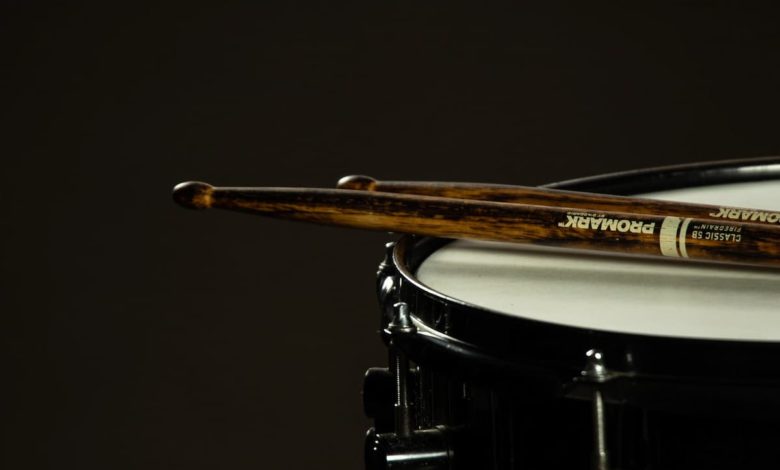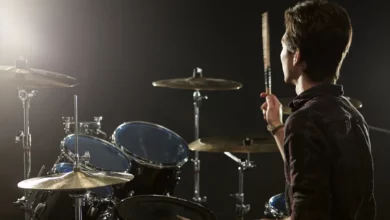
We may earn a commission from the affiliate links on this site. Learn more›
You don’t realize this until you’re standing in front of a hundred of them at the music store or scrolling endlessly through its website, but a lot goes into choosing the right drumstick.
There are white ones, black ones, orange ones. Some shorter, some longer. Some wood, some plastic.
That’s because as a tool, every stick has specific dimensions — and therefore a specific feel and sound — that it’s trying to give you. Playing metal? There’s a stick for that. Playing jazz? There’s a stick for that too — and every style in between.
Here’s a closer look at choosing the right drumstick, what should go into your decision when buying it, and how you know you’ve found the right one for you.
What Are the Parts of a Drumstick?
There are four parts of a drumstick. Let’s take a look.
Butt
The butt of the stick is the bottom of the stick. This is also where the stick is heaviest. And a lot of drummers take advantage of this when they want a deeper, fatter sound out of the snare.
In fact, you may even see drummers (including Steve Gadd) holding the stick backwards and hitting the snare with the butt end to get this effect.
And if you try it and never want to go back, you’re in luck, because you can get sticks with butts at both ends. Try Vater’s American Hickory Hammer or Morgan Rose’s signature stick for this double butt-end feature.
Shaft
The shaft is the longest portion of the drumstick. It’s between the butt and the taper and where the brand usually puts their logo.
It’s also the part of the stick that you actually hold when you play, although some drummers might distinguish between the shaft and the part you hold, which they’d call the grip area. (For the sake of simplicity, we’ll think of it as one long section.)
Taper
The stick’s taper is the part where the stick gets thinner, or narrows between the shaft and tip. And believe it or not, the length of the taper — usually called short, medium, or long — greatly affects the stick’s balance and rebound.
Sticks with a short taper, such as Ray Luzier’s signature stick, give you less rebound and more weight toward the tip. Ones with a medium taper, such as Vic Firth’s American Classic® 5A, give you an even balance without either end of the stick feeling heavier than the other.
And ones with a long taper, such as Peter Erskine’s Ride Stick, give the stick better rebound and a lighter feel, or throw of the stick, toward the tip.
Tip
Also called the bead, the tip of the stick is the most important part of what sound you get out of the drums and cymbals.
For example, if you play the ride cymbal and it sounds clangy, that’s largely (aside from the type of cymbal and size of the stick) because of the tip. If it sounds light and bright, that’s again largely because of the tip.
From oval and round to ball and acorn, there are about as many different types of drumstick tips as there are types of drummers. Aside from wood tips (hickory, maple, etc.), you also have nylon tips, which give you a much brighter and sharper sound.
What Do the Letters and Numbers Mean?
Most brands give their sticks a letter and number. The letters are usually either A, B, and S. And the numbers are usually either 2, 5, or 7.
Why these letters and numbers specifically? It’s unclear, even to the folks at Modern Drummer. At some point in the history of drumming, these referred to the type of music most commonly played with that kind of stick.
“A” was for orchestral, “B” was for marching, and “S” was for street. This isn’t the case anymore. These days, the letters aren’t really relevant to the size and shape of the stick.
The numbers, however, are. The higher the number means the lighter the stick. Counterintuitive, I know. Whereas a 7A stick is light with a smaller diameter, a 2B stick is more durable with a thicker diameter.
Does the Length of the Stick Matter?
Yes, but only for personal preference and feel. The average drumstick length is 16 inches (with an average diameter of .565). And although you might think longer sticks will be heavier, that’s not necessarily the case.
Take Questlove’s signature stick for example. At 17 inches, it’s one of the longest Vic Firth makes. Yet the diameter is .520. By comparison, their standard 7A stick — the go-to choice for many jazz players — has a diameter of .540.
Now look at Alex Van Halen’s signature stick. It’s 17.75 inches — an absolute tree trunk. But the diameter is only .570.
So again, the length of the stick doesn’t correlate to a particular weight or diameter. What matters most is how the stick fits your hand size and what response you want out of the stick.
Does the Brand Matter?
Yes and no.
Yes, because not all brands have the same standards of quality control where technology, processes, and wood selection are concerned.
And no, because — and I hate to say this again and again, but it’s true — it comes down to personal preference.
Vic Firth, ProMark, and Vater all make great sticks. But Regal Tip, Zildjian, and AHEAD do too — with great drummers across every genre endorsing them all.
This makes finding your perfect stick a numbers game. The more sticks and brands you try, the better the chances of you finding your match.
So How You REALLY Know You’ve Found the Perfect Stick?
The perfect stick is like the perfect pen: You know it when you’re holding it.
But that’s not all. The perfect stick will be a complete extension of your hand. It should do EVERYTHING you want it to do and take you EVERYWHERE you want to go around the kit.
I’ll go one step further, and say you should be able to use the stick in ANY venue with 100% satisfaction. The sound, response, and weight — everything we collectively call the “feel” of the stick — should be perfect no matter what you play, where you’re playing it, and what kit you’re playing on.
The Big Takeaway
The final point here is pretty straightforward:
If you answer “yes” — with no “ifs” or “buts” — to the question “Is this stick letting me do what I want to do?”, then you’ve found the right drumstick for you.
And there’s a great deal of satisfaction in this, because it means you’ve more than likely found the stick you’ll play for the rest of your life.
No more standing there at your music store’s stick rack until your feet hurt trying to decide between the Vater 5A or ProMark 2B. No more spending $12 on a stick that ends up collecting dust in the back of your old stick bag.
Just you, your kit, and the perfect tool that gets the job done — every time.



